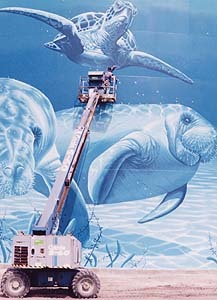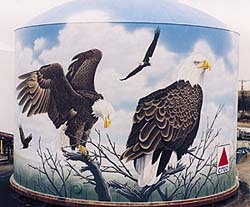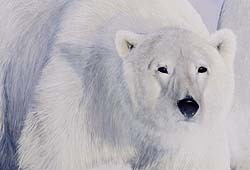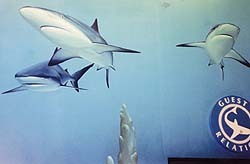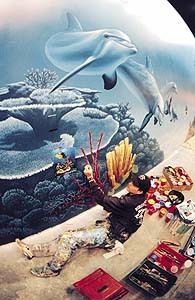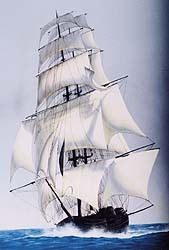Design
Water World
Muralist Eric Henn creates aquatic masterpieces for the Newport Aquarium
Published
18 years agoon
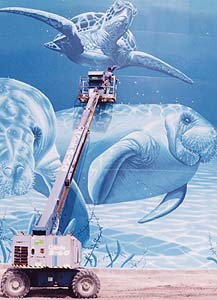
Imagine yourself an artist standing in front of a blank canvas, pondering what to paint. Any artist can explain how intimidating that empty, white rectangle can be.
Now imagine that the blank canvas measures 28,000 square feet. If you can do so, you have an idea of the kind of pressure muralist Eric Henn faced when painting the murals for the $40 million Oceanic Adventures Newport Aquarium in Newport, KY.
For Henn, the feeling was familiar. A professional muralist for 15 years, the artist has hundreds of murals to his credit, including jobs for such well-known companies as Hershey’s, Citgo Petroleum and Procter & Gamble.
But for the aquarium murals, he combated more than the usual creative pressure. Not only was the aquarium a high-profile job, it was also located in the greater Cincinnati area, Henn’s hometown.
Last year, I was on the road for 270 days,” says Henn, 34, who spent much of that time away from his wife, two young children and their Franklin, OH, home. “I was really hoping for this job. I’m known around the country — everywhere except my own backyard. I thought this would be an opportunity for me to make a name for myself where I live, which might lead to more work closer to home.”
With both personal and professional goals at stake, Henn pushed himself for six months, working 12-hour days, seven days a week — a total of more than 2,000 hours. The result: 3-D diving dolphins, painstakingly crafted polar bears, looming lifelike sharks, and a host of other sea creatures that greeted guests on May 14, when the aquarium celebrated its grand opening.
As he hoped, the aquarium’s exposure has already garnered him another Cincinnati job — murals for a new manatee exhibit at the Cincinnati Zoo. “I felt really privileged to have the opportunity to work on this project,” Henn says.
Casting a bid
These opportunities may never have happened if Henn’s wife, Shaunna, hadn’t watched the news one evening last winter. Henn was out of town on a job when Shaunna first learned about the new aquarium. Shaunna, who handles the administrative end of Henn’s business, wondered if the project would include mural work, but she had difficulty obtaining information.
“At first, we didn’t have any luck contacting anyone,” says Henn. “We spent a lot of time trying to get information.” Finally, through the assistance of a friend with connections to the aquarium, the Henns contacted the right people and submitted a bid in the nick of time.
“I was in Hershey, PA, working on a 10-mural project at Hershey’s Chocolate World,” recalls Henn. “I was talking to my wife on the phone and trying to figure out the details of this project.” The aquarium supplied only rough square-footage estimates and vague thematic outlines. Henn prefers not to bid on a job based on square footage because raw size alone is a misleading indicator of how much time a job will take.
“If it’s just clouds and sky, I can do a whole room in a few hours,” he explains. “It’s the detailed parts — the featured elements in a mural — that take the most time.” To prepare a more accurate estimate, Henn visualized each mural, and then, from experience, estimated the time each would take. He and his wife worked day and night on the estimate — Henn from his job on location and Shaunna from their home. They submitted the bid three days before it was due. “We really had our fingers crossed,” he says.
The odds weren’t in their favor. For starters, Henn estimates that he wins only one-third of the jobs he bids on. Beyond that, he was competing against mural companies comprising teams of artists. On a time-sensitive job like the aquarium, his one-man-band could be a disadvantage. “I tried not to bid too low on this job, but I really wanted to get it,” says Henn, who was eventually awarded the project because of his experience painting aquatic and wildlife scenes
To ease the minds of the aquarium developers, Henn obtained special insurance against falling behind schedule. The policy would pay cash damages to the aquarium for every day Eric was late with the project. Working 12 hours a day, Henn made sure that the May 14 deadline was never in jeopardy. “I had so little time to complete the project that I had to schedule it to the exact day — six days for this wall, 30 days for this one,” says Henn. “I had no spare days.”
Because detail is important to Henn, the tight schedule required a tricky balancing act to maintain the high-quality Henn demands. “I had to discipline myself,” he says, admitting that some days he put in 18 hours or more. “The extra hours I put in — that’s on my own.”
Henn’s extra effort and attention to detail are apparent in every one of the 17 murals now featured in the aquarium. Thirteen of the murals cover full walls, and range in size from a 26-by-80-foot arctic landscape to a 8-by-16-foot giant octopus. The other four murals enhance the walls and ceiling surrounding the two escalators and the walls within the two elevators. The escalator walls are subtle blendings of color accentuated by special wave lights that work together to create an underwater effect. Henn worked on one mural at a time, completing each before moving to the next.
For all his mural work, Henn uses Briner 5300 paint, a heavy-duty industrial acrylic that is both weather and temperature resistant. It’s the same type of paint used on tanker ships, storage tanks and large metal objects. For the aquarium murals, Henn also applied two coats of polyurethane on the finished works to protect them from scuffs and makes them easy to clean. “Except for some cloud work, I don’t use a sprayer or airbrush at all,” Henn says. “I hand-paint everything. I have various techniques for blending colors at the same time. I’ll hold five brushes in one hand and one big one in the other, and just switch the colors. I do it quickly enough so the paint doesn’t dry out.”
Henn ordered 1,900 brushes for the aquarium murals; the brushes ranging in size from seven inches wide down to 00 camel hairs. He also rented scissors and boom lifts to reach the remote areas of the walls. “I brought 325 gallons of paint on site,” Henn says. “I usually have five-gallon buckets of all the primary colors so I can mix any color I need. I mix hundreds of colors and keep them in plastic cups.”
For big areas of color, Henn smoothly blended the quick-drying acrylic paint by attacking the surface with two coats. “I rolled or brushed a solid band, applied another color next to it, waited until it dried, and then when I put the second coat on, I blended them together,” he describes. “That’s just for the background. For example, the sky in the ‘gator bayou section has 13 shades of color that fade into each other — for the gradations in the sky, and then there are clouds on top of that.”
Once the background was filled in with color, Henn sketched the featured wildlife into the scene. “I’ve never used the grid method. I always either used a projector, transferring the approved sketch to clear acetate, and then drew just a rough outline, or I just looked at a picture and hand-drew it.”
Henn also checked blueprints for wayfinding signage and furniture fixtures when creating his layout. This ensured that none of his highly detailed work would get covered up or distract aquarium visitors from other elements in the room. He needed to make sure that his murals complemented the many 3-D fixtures, such as a 26-ft tall whale sculpture (Skyline Designs, Chicago) and did not distract viewers from these wonderful installations. Everything has to work together to create the desired illusion while still leading visitors through the exhibits. Henn also tried to place details at “kid height” to excite the imagination of children. “I did that because I have kids myself, and I tried to paint things that would have an impact on them,” he says.
Another way to excite the imagination of children and adults alike is to use meticulous detail. “On the polar bears in the arctic mural, I used 32 different shades of color to create their hair,” he says. “There are at least 40,000 hairs on each of those bears — the same with blades of grass in other areas. The repetition gets boring, but if you don’t go the extra mile, it doesn’t work.”
Henn’s most convincing way to trick the eye is to create the illusion of depth. “I try to get three or four levels of depth, as in the river area where I started with ‘giant’ blades of grass. I exaggerated the perspective to create the feeling of standing on a riverbank.” The final result is a “tromp l’oiel” effect that gives the illusion of space and depth far surpassing the dimensions of the exhibit.
Tapping a profitable niche
Henn has hit his stride in the sign industry, but that wasn’t always the case. At age 19, Henn tried to get a job with a sign company in Virginia, where he lived at the time. “They liked my work, which mostly consisted of T-shirt designs, but they weren’t hiring,” explains Henn. “They referred me to Todd Lindberg, a local muralist who gave me a few jobs that he didn’t have time to handle.” Henn kept a “real” job for a few years to help pay the bills while he established himself around the Virginia Beach area. “I did everything from Harley tanks to giant murals.” Because the big mural projects paid better than the Harley tanks, Henn sought work of that nature.
Since then, he has worked on numerous projects around the country, including large-format work in Cape Fear, NC, Savannah, GA, Philadelphia, and more recently, Lexington, KY, at the Kentucky Horse Park.
Newport Aquarium Specs
Construction cost: $40 million
Marine animals: 11,000
Gallons of water in tanks: One million
Gallons of water in shark tank: 380,000
Number of sharks in tank: 50
Number of large-scale custom murals: 17
Height of tallest mural: 26 feet
Amount of paint used on murals: 350 gallons
Number of brushes used on murals: 1,900
Types of paint used on murals: Briner 5300 series, 1 Shot sign paint

SPONSORED VIDEO
Introducing the Sign Industry Podcast
The Sign Industry Podcast is a platform for every sign person out there — from the old-timers who bent neon and hand-lettered boats to those venturing into new technologies — we want to get their stories out for everyone to hear. Come join us and listen to stories, learn tricks or techniques, and get insights of what’s to come. We are the world’s second oldest profession. The folks who started the world’s oldest profession needed a sign.
You may like

NUtec Digital Ink Invests in Solar Energy for Facility

5 Reasons to Sell a Sign Company Plus 6 Options

21 Larry Albright Plasma Globes, Crackle Tubes and More
Subscribe

Bulletins
Get the most important news and business ideas from Signs of the Times magazine's news bulletin.
Most Popular
-

 Photo Gallery4 days ago
Photo Gallery4 days ago30 Snapshots of the 2024 ISA Sign Expo
-

 Tip Sheet2 weeks ago
Tip Sheet2 weeks agoAlways Brand Yourself and Wear Fewer Hats — Two of April’s Sign Tips
-

 Ask Signs of the Times6 days ago
Ask Signs of the Times6 days agoWhy Are Signs from Canva so Overloaded and Similar?
-

 Paula Fargo2 days ago
Paula Fargo2 days ago5 Reasons to Sell a Sign Company Plus 6 Options
-

 Real Deal2 weeks ago
Real Deal2 weeks agoA Woman Sign Company Owner Confronts a Sexist Wholesaler
-

 Benchmarks1 week ago
Benchmarks1 week ago6 Sports Venue Signs Deserving a Standing Ovation
-

 Photo Gallery2 days ago
Photo Gallery2 days ago21 Larry Albright Plasma Globes, Crackle Tubes and More
-

 Women in Signs2 weeks ago
Women in Signs2 weeks ago2024 Women in Signs: Megan Bradley
